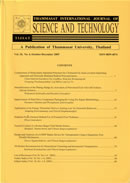ThaiScience
ThaiScience
THAMMASAT INTERNATIONAL JOURNAL OF SCIENCE & TECHNOLOGY
Volume 26, No. 01, Month JANUARY, Year 2021, Pages 170 - 179
Quantification of signal-joint t-cell receptor excision circles (sjtrecs) for age estimation in the thai population
Pairoa Praihirunkit, Pinyaphat Khamphikham, Sunisa Aob-aom
Abstract Download PDF
The age of an individual is beneficial in predicting human appearance, which can facilitate personal identification. Several studies have shown that a decrease of signal-joint T-cell receptor excision circle (sjTREC) levels in peripheral blood correlates with an increase in age. The potential application of using age-related sjTRECs has been validated in various ethnic groups, yielding a model of age estimation specific to each population. To specifically validate the use of sjTRECs as a marker for age estimation in Thais, the present study quantified sjTRECs in peripheral blood from 198 healthy individuals (20 to 91 years old) using quantitative real-time polymerase chain reaction (qRT-PCR). The results showed that sjTREC levels were negatively correlated with age (r2 = 0.60, r = -0.77). The equation for age estimation was Age = -7.776 (dCt (CtTBP-CtsjTREC))-49.39 with a standard error (SE) for age estimation of ±9.97 years. The determination of sjTREC levels in dried blood stored at a temperature between 4°C and 65°C revealed that sjTREC levels did not change in those samples stored at 65°C for 60 days, when compared to the fresh blood. This suggests that sjTRECs are relatively stable at ambient temperature in Thailand and that this age estimation model could also be applied to bloodstain samples found at temperatures up to 65°C.
Keywords
Pairoa Praihirunkit, Pinyaphat Khamphikham, Sunisa Aob-aomTHAMMASAT INTERNATIONAL JOURNAL OF SCIENCE & TECHNOLOGY
Published by : Thammasat University
Contributions welcome at : http://www.tijsat.tu.ac.th
